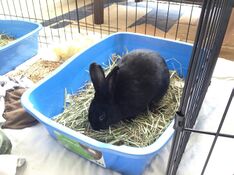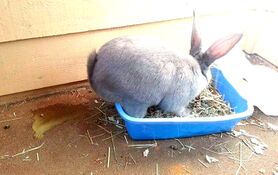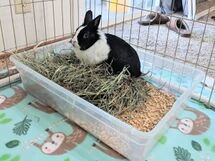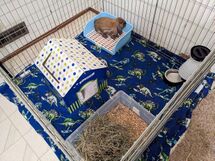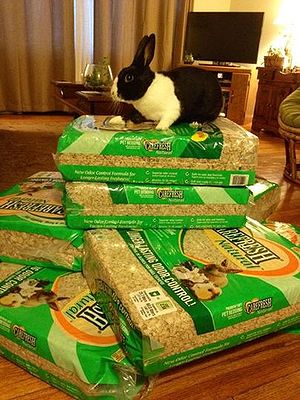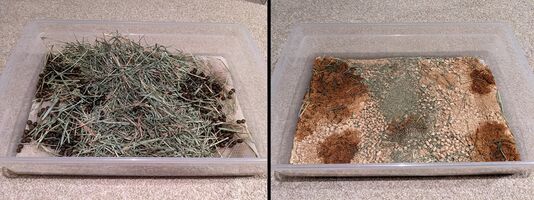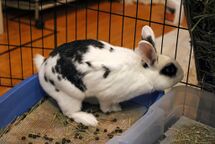Litter training
Rabbits are generally easily litter trained. By nature, many rabbits will choose to relieve themselves in the same place. However, do note that realistic litter training is that a rabbit will pee consistently in their litter boxes and nowhere else. It is very common for rabbits to poop in small amounts in their housing enclosure outside of the litter box for territorial reasons. Also, sometimes poop may be kicked out when the rabbit jumps from their litter box. This should not be a large problem because rabbit poop does not smell and is easy to pick up, sweep, or vacuum if your rabbit is healthy.
Litter boxes
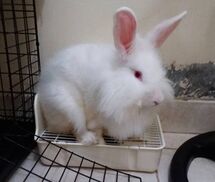
There are a large variety of products and options that are appropriate for use with rabbits.
How big should the litter box be?
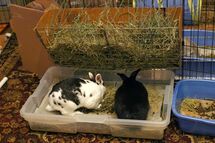
Rectangular cat litter boxes are a pretty standard choice of litter boxes for rabbit owners. These can easily be found for cheap at places like Walmart, Target, and Kmart or online at Amazon.com for around $4-8.
To decide the minimum size of cat litter box to get, use the following guide:
- under 5 pounds: medium - 16"L x 12"W x 4"H
- under 10 pounds: large - 18.5"L x 15"W x 5"H
- over 10 pounds or bonded pairs: extra-large - 23"L x 18"W x 6.5"H
Not only is a large litter box more comfortable for your rabbit to use, using a larger litter box than the minimum can also allow you to change the litter box less often as the litter will not be fully used up as quickly.
If you have multiple rabbits that share a litter box, you will want to give them plenty of room -- the bigger the better! A cheap alternative for a large litter box is an underbed storage box which come in a variety of colors, sizes, and heights. Another idea is to buy a cheap large plastic tote and cut out an entryway in one or more sides. Otherwise, have multiple litter boxes.
You can also use regular appropriately-sized clear storage totes as litter boxes, too, such as this 28 qt clear Sterilite tote.
Corner litter boxes
Many pet stores carry litter boxes that are specially marketed for rabbits. These litter boxes are typically triangular in shape and are meant to be placed in the corner of a cage or enclosure. Some examples can be found here. However, these corner litter boxes are typically only suitable for very small young rabbits and breeds unless you look for a large one.
Some large corner litter boxes available:
- Ware Plastic Scatterless Lock-N-Litter Bigger Pet Pan, Jumbo - 16"W x 11-1/2"D x 8"H
- Ware Lock-N-Litter Bigger Pet Pan, Jumbo - 16.5"W x 10-1/4"D x 8"H
- Kaytee Rabbit Large Hi-Corner Litter Pan - 20"W x 12"D x 9"H
- SmartCat Corner Litter Box - 18"W x 18"D x 8"H
- Nature's Miracle Advanced High Sided Corner Litter Box - 26"W x 23"D x 10"H
We would suggest removing the grids of the litter boxes that come with a wire floor as rabbits can break their nails and toes if they jump out badly unless it is absolutely necessary for hygiene. Some fluffy lionhead and angora rabbits may benefit with a wire floor to prevent urine staining and litter sticking to their fur, but most other rabbits do not need it.
Metal litter boxes
Non-plastic litter boxes can be a good choice for rabbits that like to chew and eat the edges of their plastic litter boxes.
One idea is to check out restaurant steam pans such as the following:
- Stainless Steel Full-Size Anti-Jamming Steam Table Pan - 4" (22 gauge) - 21"L x 13"W x 4"H
- Winco SPF6 6-Inch Pan, Full - 21"L x 13"W x 6"H
as well as stainless steel cat litter boxes:
- LIHONG Stainless Steel Cat Litter Box - 23.5"L x 15.5"W x 3.9"H
- iPrimio Ultimate Stainless Steel Cat XL Litter Box - 23.5"L x 15.5"W x 6"H
- Yangbaga Stainless Steel Litter Box for Cat and Rabbit - 23.5"L x 15.5"W x 6"H
- Aothey Stainless Steel Litter Box with Metal Lid and Scoop - 17.7"L x 13.8"W x 11.8"H
Low-sided litter boxes
If you have a disabled, elderly, or young bunny that doesn't like to or is unable to hop, try low-sided litter boxes or alternatives. You can also cut down an entry way on one side of a regular litter box to accommodate.
Some other low-sided litter boxes available for purchase:
- Bingaling Bunnybox, Geriatric Litterbox - 1" front
- Replacement Dog Crate Pan by Midwest - 1" sides
- All-Weather Indoor/Outdoor Boot Tray by Stalwart - 1.25" sides
- Tierra Garden Tidy Tray - 2.5" front
- Garland Compact Tidy Tray - 2.5" front
- Argee Table-Top Potting Tray - 2.5" front
- Camco Washing Machine Drain Pan - 2.5" sides
- Dog Litter Pan by PuppyGoHere - 3" front
- KittyGoHere Senior Cat Litter Box - 3" front
- Low Entry Senior Cat Litter Box - 3" front
- Lucky Champ Litter Pan
- Target, Under Bed Rolling Kids Storage (don't install the wheels)
Extra resources:
- DisabledRabbits.com. Litter box options for arthritic, senior, some 'tripods', disabled, and other rabbits
Litter boxes for diggers, long-haired rabbits, and litter eaters
For rabbits that like to dig, long-haired rabbits that may get litter stuck to their fur, and rabbits that can't stop eating their rabbit-safe litter, it may be a good idea to invest in a litter box setup that prevents access to the litter with a rabbit-safe mesh or grid.
To make your own gridded litter box, you can use material like plastic canvas or window screening. Be careful that the material you use will not rust or corrode due to bunny urine and that you cover or hide all sharp edges. These materials should be placed directly on top of the litter and do not directly support their weight.
If you decide to use something stiffer and heavy-duty like hardware cloth or egg-crate lighting as the main layer instead, another layer of softer mesh or rubber hole mats linked below or a thick layer of hay should be placed on top for comfort to prevent sore hocks and broken nails and toes from the larger holes.
Please note that some rabbits may not like the texture of the grids - you can cover the entire grid with a thin layer of hay instead to provide some padding or consider using a regular litter box setup without a grid instead if the separation from the litter is not necessary.
A few commercially available litter boxes with grids:
- Purina Tidy Cats Breeze XL box (don't use the litter that comes with the kit) - 29"L x 20"W
- Van Ness Pets Large Sifting Cat Litter Box with Frame - 19"L x 15"W
- Pet Mate Arm & Hammer Large Sifting Litter Pan - 19"L x 15"W
- CalPalmy Large Rabbit Litter Box - 17.3"L x 13.4"W
- Hamiledyi Large Rabbit Litter Box - 16.9"L x 13.3"W
Some commercial plastic and mesh mesh mat options:
- BinkyBunny. Litter Box and Screen Kit
- RUBYHOME rabbit mats - 13.6"L x 9.8"W
- Niteangle rabbit mats - 13.6"L x 9.8"W
- Planet Rabbit cage mat (pack of 6) - 15"L x 10"W
- YOUNTHYE interlocking outdoor drainage tiles (pack of 18) - 12"L x 12"W
Some DIY gridded litter box setup combinations:
- White Stacking Recycling Bin from The Container Store with their Basic Stack Basket. Example setup by milabuns on Instagram here.
- IRIS cat litter box with Baker's Secret Non-stick Cooling Rack. Example from u/FuzzyBinky on Reddit here.
A few DIY litter box instructions:
- u/BennyBear2121. (2021). Wanted to share the litter tray system that I mentioned in a separate post. This does a great job keeping the fresh hay and bunnies from sitting in the soiled bedding below. This is not an original idea and several tutorials can be found on YouTube by searching "DIY rabbit litter box with grate".
- Bunny Wonderland. (2016). BW Litterbox
- Coding with Bunnies. (2013). DIY Litter Box Setups
- Runestonez. (2010). The Stormhaven Litter System-Step by Step Instructions NOTE: Please add another softer layer on top of the egg crate for comfort.
- Haley. (2007). Litter Box w/Grate Idea
Covered litter boxes
In general, we would not recommend covered litter boxes for rabbits as they reduce air circulation and can make it easy to overlook regular cleaning. Build-up of ammonia can cause respiratory issues over time, so it is important to be on top of litter box cleaning if you decide to use a covered litter box for appearance or other reasons.
If you have issues with rabbits kicking out litter or feces or eating outside of their litter box, usually a high-sided litter box can solve most of these issues.
Extra resources
- Bunny Approved. (2014). Litter Box Set-Ups
- BinkyBunny. (2012). Litter Box & Hay Rack References
Appropriate litter substrate
It is important to choose a rabbit-safe material to use in the litter box.
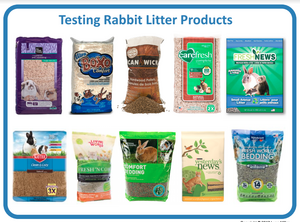
Rabbit-safe litters include the following:
- paper substrates (e.g. Carefresh, Yesterday's News, Eco Bedding, Cell-Sorb Plus, shredded newspaper and phone book pages)
- sawdust-compressed pellets (e.g. Feline Pine, wood stove pellets, pelleted horse bedding)
- straw pellets (e.g. Cat Country, Critter Country, Oxbow Eco-Straw)
- hardwood chips (e.g. aspen)
- coconut husks (e.g. Kitty's Crumble)
- hemp litter (e.g. Eaton Pet and Pasture Hemp Bedding)
The following litters are not recommended for use with rabbits:
- untreated softwood chips (i.e. pine and cedar)
- clay and clumping cat litters
- corn or wheat based litters
- CatWorks litter (manufactured by Absorption Corporation) linked to zinc poisoning, by Jeffrey R. Jenkins, DVM, Avian & Exotic Animal Hospital[1]
Untreated softwood chips can cause liver problems,[2][3] and the latter two types can cause severe problems when eaten, such as blockages and digestive problems.[4][5]
In the case of a gridded litter box, using clay and clumping cat litters and corn or wheat based litters may be safe because the rabbit will be unable to ingest the litter as long as the grate is not removed, but for your rabbit's safety, we still do not recommend using these litters if better alternatives are available in your region. Do continue to stay away from untreated softwood chips as litter because it is the aromatic oils that are potentially dangerous, not the consumption.
A few sad stories about owners using inappropriate litters with rabbits:
- East Coast Rabbit Rescue. (2019). Rabbit forced to share a litter box with two cats (RIP)
Heat-treated and kiln-dried pine chips or compressed pine pellets are safe for rabbits because the treatment and manufacturing process removes the dangerous aromatic oils,[6][7][8] but it may be dustier compared to hardwood chips.
Make sure that your bunny is not ingesting too much of the litter substrate regardless of type. If you see them doing so, you may wish to invest in a gridded litter box or make your own mesh cover for the litter.
A useful guide from the House Rabbit Society to print out when shopping for litter brands can be found here. See Costs of rabbit ownership#Litter costs for a comparison of prices of litter.
Some resources on making your own litter:
- Hamster Hideout. (2014). Making your own bedding from recycled paper
Preparing your litter box
A basic litter box should consist first of a layer of your chosen litter substrate and then a layer of hay to encourage your rabbit to eat in it. It may sound unsanitary, but rabbits tend to eat and poop and pee at the same time and place. As a result, keeping their food in or near a litter box will help encourage proper litter habits. If you are worried about your rabbit getting sick from trying to eat soiled hay, rabbits will not consume the urine-soaked hay and will dig and eat around it.
While you are litter training, you may also wish to place some of the bunny's poops and urine-soaked paper or hay in a fresh litter box to let them know that the litter box is an acceptable place to potty.
How much litter should I put inside?
A thin layer of around an inch of most types of litter substrates is sufficient if you change the litter box every day or every other day. If you wish to change the litter box less, put a layer of around 3-4 inches of litter substrate - your will probably be okay for at least 3 days depending on substrate type, but this will depend on the litter habits of your rabbits and how many rabbits are using the single litter box.
The main reason to change a litter box is due to the odor or lack of litter substrate left to absorb urine. Urine is the main cause of rabbit odor and is used as the main method by rabbits to mark territory. Your rabbit will probably produce mountains of poop but it is not as big of an issue for sanitation as soaked litter.
If your rabbit seems to not use their litter box after a while, it may be because it is too dirty. Rabbits are meticulous creatures, as you can tell from their grooming habits, and some rabbits will not use dirty litter boxes. Additionally, if urine is in contact with the rabbit's paws too long, it will stain and may even burn their feet. As a result, please make an effort to change your rabbit's litter box regularly.
For bunny owners that use wood pellet litters, you can make the pellets go much further by pre-expanding the pellets with water before use in a litter box. The absorption efficiency is the same, and you can use even less litter for the same effectiveness!
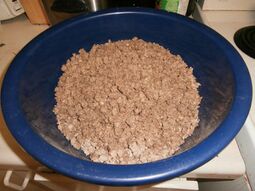
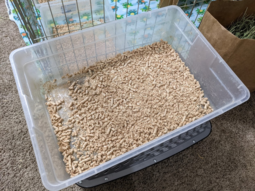
How can I reduce hay waste?
Some may be concerned at the waste of hay by placing it in the litter box. The waste can be usually be reduced by instead placing a hay rack near the litter box so that the rabbit can sit in the box and eat. It is less of a concern if you have bought a bale of hay for your rabbit. However, please note that some rabbits may enjoy pulling out all the hay from the hay racks anyways before consuming any, which would defeat the purpose of the purchase.
Ultimately, it is a good idea to combine the location of the hay feeding and bathroom to encourage proper litter training, and important not to be too stingy with hay wastage. Hay is a very important part of their diet, and inadequate consumption can lead to more serious health problems and expensive vet bills that end up more costly than buying some extra hay.
Should I use litter box liners?
In general, we do not recommend using plastic litter box liners or disposable pee pads (anywhere in the rabbit’s enclosure— not just in the litter box) as they are environmentally wasteful and can be incredibly dangerous if the rabbit decides to chew on them. Disposable pee pads are made to be absorbent so are extremely risky if your rabbit ingests the padded part, as it will expand in the stomach and can cause a fatal blockage. Please note that even if your rabbit may not have shown interest in chewing on something in the past, that does not mean they never will. Rabbits are very opportunistic creatures and may change preferences at a moment’s notice, including chewing tendencies and behaviors.
If you would like an environmentally friendly and compostable option, using newspaper or magazine pages (only if the rabbit doesn't dig and chew at them) is safe to help make cleaning the bottom easier.
Extra resources
Some more links to read for more information on setting up a litter box have been listed below.
- San Diego House Rabbit Society. Setting Up Bunny's Litterbox
Changing the litter box
Typically, the entire litter box is dumped and refreshed when it is time to change the litter.
If you are more proactive, you can go through and scoop out only the wet litter and replace that section. A gridded litter box can allow you to recoup the most hay and make it easier to pick out the poop and scoop out wet litter.
If provided with appropriately sized and number of litter boxes, owners should not need to change litter boxes more than once a day. Most rabbit owners change the litter box once every 2 to 4 days, depending on their set-up, standards, and their rabbit's preferences. Be careful about changing the litter box too often. The rabbit can get the impression that they are not supposed to use the box if they never find their scent there. Note that the need to change the litter box should be distinct from refreshing and refilling hay. If you see that your rabbit's litter box is low on hay, do not wait until you change the litter box to refill it.
Use vinegar (cheap white grocery store vinegar is sufficient) to wipe down the litter box to dissolve any deposits that rabbit urine leaves. You can dilute this down to 1:1 water:vinegar or use straight full concentration vinegar. Leave it to soak for a while for especially stubborn white stains - you may also need to assist with some manual scrubbing.
This mixture is also useful to help clean surfaces that your bunny has marked. The vinegar will break down the scent to reduce urges to re-mark.
For owners that live in an apartment or would like to do it indoors, the easiest and tidiest method is to put the entire litter box in a trash bag and then shake it hard to dump out all the litter. Follow up with a quick wipe with a wet paper towel soaked in vinegar. You may also choose to rinse the box in the bathtub, but be careful about cleaning out all the solids in the litter box first or they may clog your drain.
For owners with a yard, you can usually dump the entire litter box contents into a compost pile if you don't use plastic liners, and hose down or power wash the box on the lawn to clean off the rest.
What do I do if I have a fly or gnat infestation around my litter box(es)?
If you are having issues with flies and gnats around your litter boxes, you will need to clean more regularly and thoroughly to break the life cycle of the bugs.
House flies take about 8 to 20 hours to hatch from fertilized egg to larva and another 7-10 days to grow to a breeding adult.[9] Fungus gnats take about 5-6 days to hatch from fertilized egg to larva and another 15-20 days to grow to breeding adult.[10] It is essential to clean often and thoroughly enough that the eggs and larva do not have the opportunity to grow to an adult to breed and lay more eggs in the litter.
Consider using multiple litter boxes to thoroughly disinfect and dry the litter boxes in between cleanings. Wash the litter box with mild detergent, white vinegar, or bleach to kill off any eggs that may be left on the sides after the litter and waste are dumped. Make sure to toss dirty litter outside immediately and do not keep it indoors.
To control adult insects, vacuum any bugs that sit to rest on walls and nearby future and put up fly tape and larger fly traps above the litter box and out of your rabbit's reach.
It may take a few weeks of regular cleaning to control the infestation. Make sure to regularly check your rabbit's bottom as well to make sure that it is clean to avoid the additional dangerous risk of flystrike, especially in warm weather.
Training methods
As a note to begin with, before we go into training methods, spaying or neutering your rabbit will go a long way towards consistent litter habits. As Dana Krempels, Ph.D., states,[11]
The most important thing to remember is that your rabbit is very unlikely to retain reliable litterbox habits upon reaching sexual maturity unless she is spayed/he is neutered. Sex hormones give a rabbit an uncontrollable desire to mark the territory with urine and specially scented fecal pellets. Spay/neuter will eliminate/greatly reduce this drive, as well as eliminate the risk of uterine/ovarian cancer and unwanted pregnancy in females. And let's not forget the huge relief from endless sexual frustration that spayed/neutered animals enjoy.
Once you have set up a proper litter box, place it in area where the bunny can be comfortably confined for a couple of days except when let out for exercise and play. You may place it in any corner of the housing enclosure but be warned that you may need to move it if the bunny decides to pick their own potty corner. Rabbits are rather stubborn, and it tends to be easier to go along with their choice rather than try to adjust them. Reward the rabbit with more and more free space when they pee and poop in the litter box consistently.
It is expected that the bunny will have poor litter habits the first few days, but clean up any messes not in the litter box with a mixture of 1:1 vinegar:water or a pet-friendly enzymatic cleaner like Nature's Miracle to rid of the scent and discourage the urge to re-mark. Plain soap and water are not sufficient to clean out all traces of urine scent. If you catch the rabbit peeing or pooping outside, try to interrupt them and move the rabbit in the litter box. Reward with treats whenever you see the rabbit going in the right spot. You may also place some pee-stained papers and poop pellets in the litter box to let them know that it's an acceptable place to potty.
The hay in or over the litter box should encourage proper litter habits since, disgusting as it may seem to humans, a rabbit will often happily munch on one end and potty from the other at the same time. You can reinforce the behavior by rewarding the rabbit with a healthy treat when you see them sitting in the litter box.
Do not get too frustrated with the rabbit if they do not seem to be getting the point. Remember, rabbits do not respond well to physical discipline. They are easily frightened and hurt. Some bunnies may take a while to learn but generally should get better in a week or two. A rabbit at any age can learn proper potty habits given enough time and motivation.
If there are particular problem areas that you can't seem to get your rabbit to stop urinating in, you may need to add another litter box there, cover it with a slick material like a marble tile to make it unattractive for urination, or even remove the problematic surface or block off the area completely.
Common problems
While many times rabbits will litter train themselves easily, other times rabbits will refuse to properly litter train for a variety of reasons.
Eliminating outside of the box
Although rabbits are typically easy to litter train, baby rabbits may have difficulty learning to keep consistent litter habits. Additionally, after puberty, many rabbits may display problem behavior such as spraying and marking outside of the litter box and peeing on beds and couches. The cause for this varies, but in many cases can be solved by spaying or neutering an intact rabbit.[12][13]
If your rabbit is already neutered, angry bunnies may intentionally pee to show their displeasure.[14] The Litter Training FAQ also has more ideas on how to specifically teach your rabbit from peeing in a certain area. If the rabbit has never wanted to use their litter box, consider that it is appropriately sized and placed and experiment with different shapes and litter textures. If your litter box has a grate, many rabbits may not find it comfortable. Consider covering the grate with a layer of thin hay or remove the grate altogether.
If your rabbit has regressed in litter training consistently ever since puberty even after a neutering, it may be worthwhile to run bloodwork to make sure their hormonal levels are within normal range for a neutered rabbit. Retained reproductive tissues, other organs from being intersex, or adrenal issues can cause abnormal hormonal behavior even after the main reproductive organs have been removed.
Some rabbits like to lounge in their litter boxes and consequently will not use them to poop and pee in. In this instance, try offering other sleeping locations like a cardboard box or a pet bed or provide another litter box that they can properly use to not soil their sleeping location.
If your rabbit has been consistently excellent with litter training, but it has suddenly changed, environmental changes, stress, and medical problems can also cause poor litter habits. The introduction of a new pet (another rabbit, cat, dog, baby, visitor, boyfriend, etc.) can easily cause your rabbit to feel territorial and pee and poop everywhere. The same may occur if you move around furniture too much or move to a new place. However, as the rabbit gets used to the new environment, their litter habits should return to normal. If no stressful or environmental factors can be detected, your rabbit may have a urinary tract infection (UTI) or another condition that is causing a weak bladder, especially if you see small dribbling spots as they hop. In this case, please take your rabbit to your rabbit-savvy veterinarian to be properly diagnosed and medicated if necessary.
If the rabbit reliably uses their litter box in their area yet consistently pees in another corner when let free to exercise and play, you may wish to set up another litter box in that corner if properly cleaning up after them does not change their behavior. Like stated before, rabbits are very stubborn, and it may be easier to compromise.
Some rabbits may accidentally eliminate over the side of the litter box, especially if it gets too full of hay. Rabbits typically shuffle back into a corner and lift their tails to urinate, and if the tray is too shallow, the rabbit may miss the edge. To fix this issue, use a litter tray with higher sides or make your own urine guard. One idea is to use a plastic folder as a urine guard. This may also happen with a litterbox that is too small for your rabbit.[15]
Digging in the box
Rabbits have a natural instinct to dig, and this sometimes results in them digging in the litter box and thus flinging hay, litter, and poop everywhere.
Firstly, you can try to redirect their attention with an appropriate digging box - read more in the Toys article about how to set up a safe space for this behavior. Also make sure that your rabbit has sufficient space and mentally stimulating favored toys in their room or pen, as bored rabbits will like to make messes to entertain themselves.
There are a few options you can try to prevent messes if your rabbit continues to insist on digging out their litter box.
- A gridded litter box with litter underneath the mesh portion prevents the rabbit from digging out the litter, but the rabbit may continue to dig out the hay on top. See the previous section Litter boxes for diggers, long-haired rabbits, and litter eaters for more tips and resources on setting one up.
- You can place the litter box in a larger cardboard box to contain the mess and make it easier to clean up.
Smelly litter box
If your litter box smells, that is often a sign that you should be changing your litter box more frequently. A good litter box should not give off any significant ammonia odor.
If you find that you are changing the litter too often, the following tips may be useful:
- Type of litter. Generally, wood-based litters will absorb more odor and urine than paper-based litters. Pelleted litter will also be more efficient than shavings. The Testing Rabbit Litter Products comparison slideshow by Lynn Miller can also be useful in deciding on the best litter for your situation.
- Size of litter box. The larger the litter box, the less often you will need to clean it since there will be more litter to soak up urine and its smells.
- Amount of litter. Wood pellets will only need a very thin layer as it is incredibly efficient and will swell as it gets wet. However, if you are using a paper-based litter, you may need to add a thicker layer to extend the use of a litter box safely.
Extra resources
The following are some additional resources about bad litter box habits.
- The Rabbit House, Rabbit Behaviour Problem: Bad Litter Box Habits
- Rabbit Welfare Association & Fund, Linda Dykes, Help! I can't housetrain my rabbit. Updated Feb 2002.
Further reading
- House Rabbit Resource Network, Rabbit Litter Information
- SaveABunny.org, Litterbox Training Your Bunny
- House Rabbit Network, Kathy Smith, The Basics of Litterbox Training. (2003)
- House Rabbit Society, Litter Training
- House Rabbit Society, Marinell Harriman, Litter Training: for those who want to but can’t
- House Rabbit Society, Amy Espie, Litterbox Encore
- San Diego House Rabbit Society, Litterbox Training
- Precision Pet Products, Rabbit Litter Box Training Guide
- Kathy Smith, Supplies
- Kathy Smith, Nobody’s Perfect. (2004)
- The Rabbit House, Rabbit Litter Training
Here are some relevant discussions on litter training rabbits.
- Flickr, Bunny Lovers Unite, BLU Guide: How to litter train
The following are some relevant videos:
References
- ↑ Zooh Corner Rabbit Rescue, Zinc Poisoning Linked to Litter
- ↑ House Rabbit Society, Marinell Harriman, Litterboxes and Liver Disease
- ↑ House Rabbit Society, George Flentke, Ph.D., The Dangers of Softwood Shavings
- ↑ Zooh Corner, Jeffrey R. Jenkins, DVM, Zinc Poisoning Linked to Litter
- ↑ Zooh Corner, Litter Boxes, Liver Disease and Your Rabbit
- ↑ Corinne Fayo, The Truth About Pine Shavings
- ↑ Raising-Rabbits.com, Rabbit Litter
- ↑ House Rabbit Society. (n.d.) Litter Training. Retrieved 29 Sep 2016 from http://rabbit.org/faq-litter-training-2/
- ↑ University of Florida. (2017). house fly. Retrieved 03 Sep 2024 from https://entnemdept.ufl.edu/creatures/urban/flies/house_fly.htm
- ↑ Oklahoma State University. (n.d.). Fungus Gnats. Retrieved 03 Sep 2024 from https://extension.okstate.edu/programs/digital-diagnostics/insects-and-arthropods/fungus-gnats-bradysia-and-sciara/
- ↑ Dana Krempels, Ph.D., Training Your Rabbit: Reality 101
- ↑ House Rabbit Society, FAQ: Litter Training
- ↑ Wikihow.com, How to Litter Train a Rabbit
- ↑ The Language of Lagomorphs, Offended Rabbits
- ↑ allcreaturesrescue.org Rabbit litterbox recommendations


